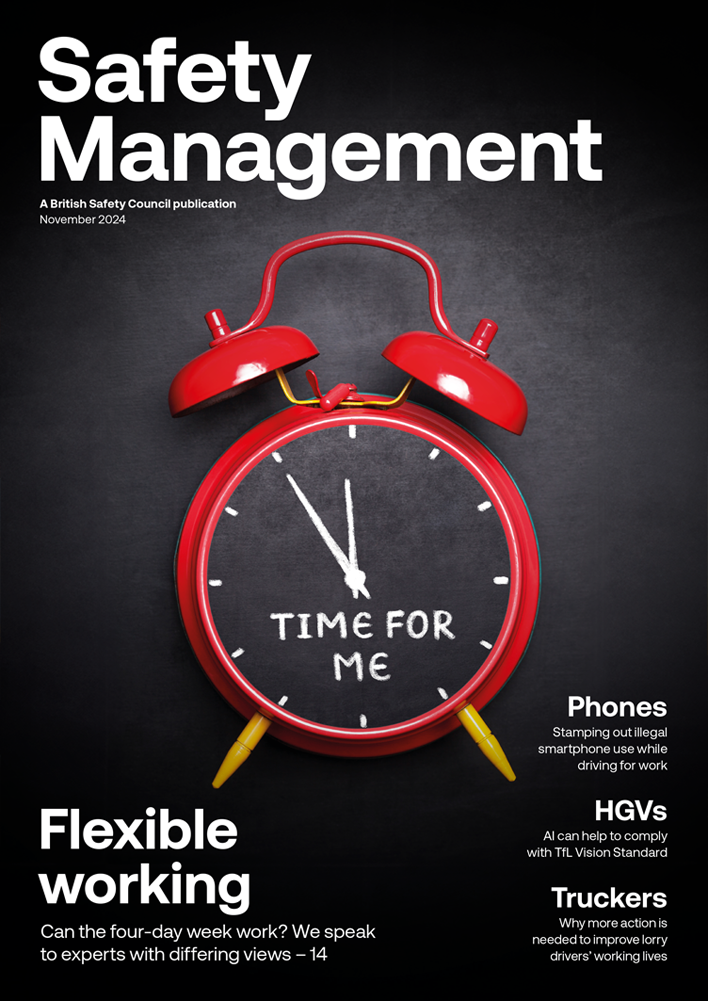Professor Tim Marsh will be speaking at the SHW Live exhibition in Manchester in May on ‘Enabling Individual and Organisational Thriving’, and has written the following for Safety Management on the importance of wellbeing to our safety at work.
Features
It’s ‘good to walk’ – why better wellbeing helps safer working
A good, regular ‘walk and talk’ with staff is a practical way a director, manager or supervisor can seek to ensure that individuals are thriving in terms of their mental wellbeing and overall performance at work. Such conversations are also a great way of enabling staff to speak about mental health, but only if they are conducted with genuine empathy.
If management are serious in their intent, a good walk and talk allows for both an exchange of ideas about how best to improve health and safety (including mental wellbeing), and for management to demonstrate ‘visible felt leadership’ and commitment – in other words, showing they respect staff and are concerned about their wellbeing.
 A good walk and talk allows for both an exchange of ideas and for management to demonstrate ‘visible felt leadership’. Photograph: iStock
A good walk and talk allows for both an exchange of ideas and for management to demonstrate ‘visible felt leadership’. Photograph: iStock
Indeed, two key consequences of such a conversation are that first we learn things that can be useful for improving health, safety and wellbeing and second in doing so (and genuinely saying thank you), we empower and engage the colleague we’ve been interacting with.
So, in one proactive, person-focused dialogue, we help move the organisation beyond a merely compliant culture – where basic health and safety standards are reached but health and safety excellence remains some way off – to building a true culture of health, safety and wellbeing excellence.
But there’s also something going on during such a conversation that can underpin both destructive vicious circles and constructive virtuous circles where ‘behaviour breeds behaviour’. This is largely due to two cocktails of chemicals, in our unseen, subconscious back brain function, made famous by Daniel Kahneman’s book Thinking, Fast and Slow.
In other words, employees may be experiencing one of two chemical ‘cocktails’ in their body that either have a negative or positive effect on their mental wellbeing – and the nature, type and frequency of conversations between managers and staff on issues like employee mental wellbeing play a role in determining which of these mental ‘cocktails’ staff will experience.
The first cocktail is composed of mostly adrenalin and cortisol and these chemicals occur when we are, for example, stressed, uncertain, anxious, frustrated or feel we have been treated unfairly. The problem with these is that they automatically increase:
- Intolerance
- Irritability
- Criticality (blame).
And reduce or impair:
- Memory
- Creativity
- Decision-making
It’s clear this cocktail is not exactly ideal for organisational efficacy under any circumstances and that the benefit of ‘good work is good for you’ will not be applying to the individual in question. They will not be going home fulfilled and happier than when they arrived!
 Professor Tim Marsh: "When seeking to improve the workplace health and safety culture and reduce risk it’s always better to be positive and proactive."
Professor Tim Marsh: "When seeking to improve the workplace health and safety culture and reduce risk it’s always better to be positive and proactive."
Increasingly, we’re understanding that people with this negative mindset tend to have more accidents at work. The word ‘tend’ is key, as it is a complicated relationship. As a major study by Martin Seligman (who wrote the book Flourish) shows, it is also true that positive, optimistic people get readily, and optimistically stuck in, equally increasing the likelihood of an incident. Though, on the upside, they return to work more quickly, are less likely to claim and contribute more effectively to incident investigations.
Overall, however, people facing or ‘struggling’ with poor mental health are more likely to make bad decisions, have bad interactions, be fatalistic and be distracted and low in situational awareness. All which are known to contribute to the frequency of harmful – or even potentially harmful – incidents and situations at work.
‘Struggling’ workers less likely to contribute to a good safety culture
Studies around the world are limited and we desperately need some meta-analysis papers but it’s broadly true that, on balance, ‘struggling’ people are twice as likely to have an incident and half as likely to contribute positive, culture creation behaviours – such as helping new starters, volunteering for training or intervening when something risky is noted.
Jason Anker MBE, my colleague at Anker & Marsh who was paralysed in a fall in 1993 from an unsecured ladder, is a case in point. He came to the realisation that on the day of his accident he had become fed up with a job that paid well but kept him away from his wife and children. He’s since spent decades as a motivational speaker urging workers to pause and ‘take five seconds’ to assess the health and safety risks, and avoid the same sort of accident that happened to him.
 Some people like a little interpersonal contact and others a lot but everyone wants that contact to be good quality. Photograph: iStock
Some people like a little interpersonal contact and others a lot but everyone wants that contact to be good quality. Photograph: iStock
Clients of Anker & Marsh consistently report that delivering toolbox talks based on our ‘fatalism and intolerance of organisational, societal and individual stressor’ (F.I.) scale generate hugely useful dialogue among the workforce on low-grade mental health issues.
Our ‘F.I. scale’ is a user-friendly way of talking about what we used to call ‘stress’ before we uncovered, for example, that 80 per cent of people off with ‘bad backs’ were in fact struggling with low-grade mental health issues.
We know that when seeking to improve the workplace health and safety culture and reduce risk it’s always better to be positive and proactive than negative and reactive. Put simply, let’s hit the bar a second time and try a different cocktail.
The more positive cocktail comprises dopamine, oxytocin and endorphins and these are generated by approaches such as humour, engagement and empathy – for instance, when employed by managers in their conversations and dealings with staff. These promote:
- Calmness
- Focus and attention
- Creativity
- Generosity
- Bonding
- Trust (studies suggest this is perhaps the most important psychosocial issue of them all).
No doubt, we can all agree that the above is the kind of positive cocktail we need to create if we are to realise the benefits of a positive organisational culture around mental health.
Mental health initiatives like Trauma Risk Management (TRiM), a trauma-focused peer support system designed to help people who have experienced a traumatic, or potentially traumatic, event, have shown that talking with peers about mental health is often more effective than talking to trained professionals. With ONS statistics showing we’re 31 times as likely to lose a colleague to suicide than to an accident, we’re increasingly understanding that mental health triage is an area we need to address at work with everything we have at our disposal.
So, it’s about listening to – and asking after – people who look to be struggling to get them to start talking about any mental health problems they are experiencing.
Supporting workers to thrive
Researchers such as Paul Zak have built on the work of Peter Warr, who developed a model called the ‘Vitamin Model’, to describe the most common (and most researched) job characteristics that impact employee wellbeing and development. They have published lists of work-related issues we need to consider when seeking to ensure that employees’ mental health is supported and that all staff are able to thrive and perform to the best of their ability.
These models suggest employers should be looking at levels of employee autonomy, skill development, workers understanding how their role fits with the bigger picture, workers feeling their job has meaning and purpose, and the amount and quality of interpersonal contact at work, as these all contribute to positive (or negative) mental health and workplace performance.
Here are two examples of how employers need to ‘flex’ their approach to supporting worker mental health. Some people like a little interpersonal contact and others a lot but everyone wants that contact to be good quality. Some people like so much autonomy they can only really function as self-employed workers but others, when given that level of autonomy, would never sleep at night.
The conversations are straightforward to have but, as with everything else of value, organisations just need to find the time and commitment to facilitate them, and then act on them.
Register for the free SHW Live exhibition in Manchester on 23-24 May:
www.safetyhealthwellbeing.live
Professor Tim Marsh is managing director at Anker & Marsh Ltd
FEATURES

Winter pressures mean good mental health support is crucial
By Kevin Bampton, British Occupational Hygiene Society on 01 December 2021
I will tell anyone who cares to listen that winter 2020/2021 was a historic moment in British social and economic history. British business became, for the first time ever, my public health hero.

The big sleep
By Marcus Herbert, British Safety Council on 01 December 2021
Poor quality sleep can affect both our physical and psychological wellbeing, but simple lifestyle changes can make a big difference.

Why changes to recycling legislation in England are an opportunity, not a burden
By Adriana Olaya Rodriguez, Newell Brands on 12 November 2024
From March 2025, many businesses in England will have to begin separating their recyclable and food waste from general waste prior to collection, but the changes will bring wider business benefits, such as reduced waste disposal costs and improved sustainability credentials.



